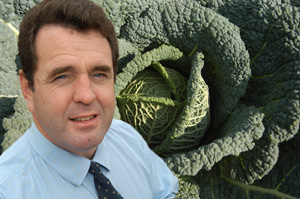
Syngenta has added to the strength of the world's best selling strobilurin fungicide, Amistar. The new approval of Amistar TOP for use in brassica crops now gives growers all the existing benefits of full rate azoxystrobin, with the powerful addition of difenoconazole.
The combination gives outstanding disease protection coupled with strong curative activity against all key brassica diseases, according to Syngenta Speciality Crops Manager, Bruce McKenzie. "Amistar TOP is designed specifically to meet the demands of today's grower.
"In an era when growers are looking to avoid routine prophylactic fungicide inputs it is increasingly difficult to rely on purely preventative fungicides. The power of a higher rate of difenoconazole in Amistar TOP gives valuable added curative properties, to ensure growers can still consistently produce top quality brassicas," he reports.
Amistar TOP has proven to give the best control of a broad-spectrum of diseases and extend the shelf life of different brassica crops, including Brussels sprouts and cabbage; "it sets a new standard for disease control in brassicas," says Mr McKenzie.
The label approval Amistar TOP is for the control of White blister (Albugo candida) and Powdery mildew (Erysiphe cruciferarum). When used for control of other diseases, AMISTAR TOP applied as a protectant treatment will also control Alternaria (Alternaria brassicae and Alternaria brassicicola) and Ring spot (Mycosphaerella brassicicola).
Although brassicae growers have had difenoconazole available as Plover, Mr McKenzie highlights that the Amistar TOP effectively now delivers a higher rate of the curative partner than previously possible. "In milder growing conditions many brassica diseases are hitting earlier and more aggressively. Amistar TOP gives growers the opportunity to tackle disease more effectively," he advises.
Amistar TOP is an easy to use low-dose liquid formulation popular with operators. At the recommended application rate of 1 l/ha Amistar TOP includes 200g of azoxystrobin (equivalent to 0.8 l/ha of Amistar) and 125 g of difenoconazole (equivalent to 0.5 l/ha of Plover). Growers can make two applications a year, along with continued use of Amistar and Plover in accordance with FRAC guidelines.
"The combined formulation is an integral part of strobilurin resistance management that not only delivers a better product for growers, but minimises packaging waste for disposal. Furthermore, since only one product is being moved through the distribution chain, it gives a lower cost for equivalent product and a lower environmental footprint," adds Mr McKenzie.
In cabbage trials last year, Amistar TOP reduced Powdery Mildew infection in cabbages from 15% in untreated plots to less than 0.5% - a significantly better result than Amistar alone and 24% better than boscalid + pyraclostrobin. It also totally eliminated Alternaria when the untreated crop had 11% infection; boscalid + pyraclostrobin gave only 80% control. In Ringspot, White Blister and Xanthamonas trials Amistar TOP also outperformed other strobilurin fungicides.
The result of enhanced disease control has been improved marketable yield and, equally importantly for packer processors and retailers, longer shelf life. Studies by Lincolnshire Field Produce revealed the appearance of Amistar TOP treated Tundra cabbages from a Powdery Mildew infected crop was still green five weeks after cutting, when the untreated crop had yellowed and wilted - and would have been consigned to the bin long before.
Brussels sprout trials in Lincolnshire and Lancashire, also confirmed the improved marketable yield from Amistar TOP treatments. A 95% reduction in buttons affected by Ringspot translated into a 16 t/ha increase in marketable yield over the untreated, and 10% more saleable crop than boscalid + pyraclostrobin.
Amistar TOP is already approved for use in carrots and leeks, with Specific Off label Approvals in parsnips, horseradish, parsley root, salsify and asparagus. Brassica crops covered by the new label approval include Brussels sprouts, cabbage, cauliflower, broccoli/calabrese, kale (winter greens) and collards (spring greens).
